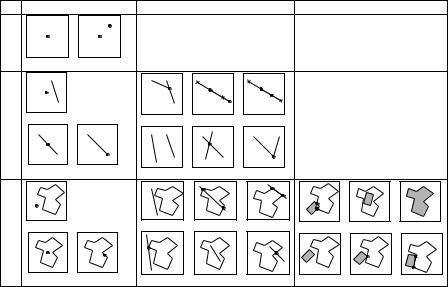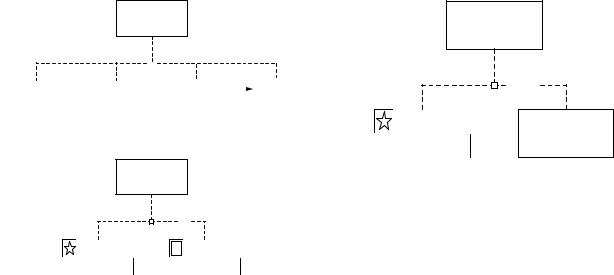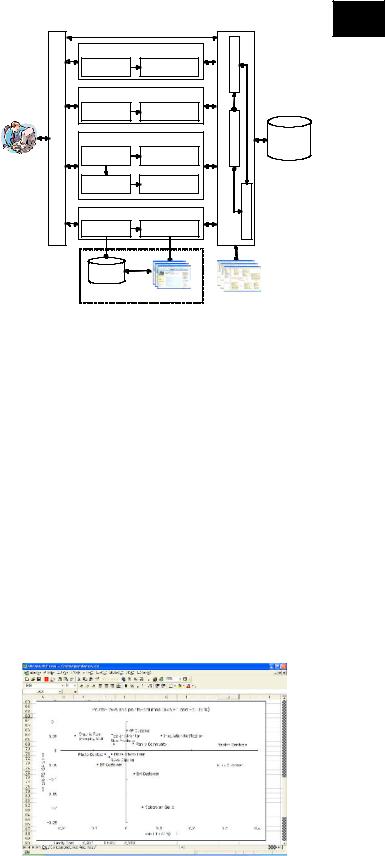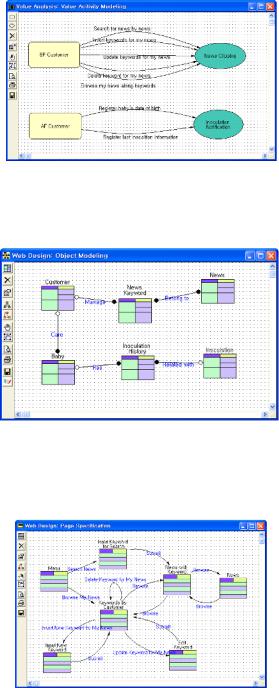
Rivero L.Encyclopedia of database technologies and applications.2006
.pdf
Deriving Spatial Integrity Constraints from Geographic Application Schemas
Table 4. Spatial relationships
|
|
Point |
|
Line |
|
|
Polygon |
|
P |
|
|
|
|
|
|
|
|
o |
|
|
|
|
|
|
|
|
i |
|
|
|
|
|
|
|
|
n |
IN |
DISJOINT |
|
|
|
|
|
|
t |
|
|
|
|
|
|
||
|
|
|
|
|
|
|
|
|
s |
|
|
|
|
|
|
|
|
L |
|
|
|
|
|
|
|
|
i |
|
|
|
|
|
|
|
|
n |
DISJOINT |
|
TOUCH |
OVERLAP |
OVERLAP |
|
|
|
e |
|
|
|
|
||||
|
|
|
|
|
||||
|
|
|
|
|
|
|
|
|
|
TOUCH |
TOUCH |
DISJOINT |
CROSS |
TOUCH |
|
|
|
|
|
|
|
|
|
|||
P |
|
|
|
|
|
|
|
|
o |
|
|
|
|
|
|
|
|
l |
|
|
|
|
|
|
|
|
y |
DISJOINT |
|
DISJOINT |
CROSS |
TOUCH |
OVERLAP |
IN |
IN |
g |
|
|||||||
|
|
|
|
|
|
|
|
|
o |
|
|
|
|
|
|
|
|
n |
|
|
|
|
|
|
|
|
|
IN |
TOUCH |
TOUCH |
IN |
CROSS |
DISJOINT |
TOUCH |
TOUCH |
|
|
|
by upper-case italic letters (e.g., A, B), their boundaries are denoted as ∂Α, and their interiors as Ao (note that Ao = A - ∂Α). The boundary of a point object is considered to be always empty (therefore, the point is equivalent to its interior), and the boundary of a line is comprised of its two endpoints. A function, called dim, is used to return the dimension of an object and returns 0 if the object is a point, 1 if it is a line, or 2 if it is a polygon. Notice that additional constraints can be formulated in case some other relation is required by the application. Table 4 shows examples of the geometric interpretation of the spatial integrity rules between lines, points, and polygons.
Some relationships are only allowed between specific classes because they depend on the geometric representation. For instance, the existence of a contain relationship assumes that one of the classes involved is a polygon. In this aspect, traditional applications differ from geographic ones, where associations between conventional classes can be freely built.
The near rule is the only one described in Table 3 that requires a parameter. Since the notion of proximity varies according to the situation, a precise distance must be supplied in order to allow for the correct evaluation of the relationship.
In OMT-G, network relationships involve objects that are connected with each other. A network relationship only shows the need for a logical connection, not a requirement for the implementation of a particular structure. The connectivity rules, which apply to network relationship primitives, are listed in Table 5. The connec-
tion between all types of nodes and segments must be ensured by the system.
Generalization and specialization relationships do not generate the need for any additional integrity constraints, other than the ones expected in conventional databases; therefore, relationships of these kinds will not be treated here. Aggregation is a special form of association between objects, where one of them is considered to be assembled from others. The graphic notation used in OMT-G follows the one used by UML. An aggregation can occur between conventional classes, georeferenced classes, and georeferenced and conventional classes. When the aggregation is between georeferenced classes, spatial aggregation must be used (Figure 5). The usage of this kind of aggregation imposes spatial integrity constraints regarding the existence of the aggregated object and the corresponding sub-objects (Table 6): the geometry of each part is entirely contained within the geometry of the whole, and no overlapping among the parts is allowed. Also, the geometry of the whole is fully covered by the geometry of the parts. In Figure 5, city blocks are composed of parcels; that is, blocks are geometrically equivalent to the union of adjacent parcels. This implies that (1) no area belonging to the block can exist outside of a parcel, (2) no overlapping can occur among parcels that belong to a block, and (3) no area belonging to a parcel can exist outside of a block.
The spatial primitive conceptual generalization is used to record the need for different representations for a given object (Davis & Laender, 1999). In this type of
180
TEAM LinG

Deriving Spatial Integrity Constraints from Geographic Application Schemas
Table 5. Connectivity rules
Arc-node |
Let G = {N, A} be a network structure, composed of a set of nodes N = {n0, n1, ..., np} and a set of |
|
structure |
arcs A = {a0, a1, ..., aq}. Members of N and members of A are related according to the following |
|
|
constraints: |
|
|
1. |
For every node ni N there must be at least one arc ak A . |
|
2. |
For every arc ak A there must be exactly two nodes ni ,n j N . |
|
|
|
Arc-arc |
Let G = {A} be a network structure, composed of a set of arcs A = {a0, a1, ..., aq}. Then the |
|
structure |
following constraint applies: |
|
|
1. |
Every arc ak A must be related to at least one other arc ai A , where k ≠ i . |
|
|
|
Figure 5. Spatial aggregation (“whole-part”)
|
|
B lock |
|
|
|
P arcel |
|
|
|||||
|
|
|
|
|
|
|
|
|
|
|
|
|
|
|
|
|
|
|
|
|
Table 6. Spatial aggregation integrity rules
Spatial |
Let |
P = {P0 , P1,K, Pn } be a set of geo-objects. Then P forms another object W by spatial aggregation |
||
aggregation |
if and only if |
|
||
|
1. |
Pi ∩W = Pi for all i such that 0 ≤ i ≤ n , and |
||
|
|
|
n |
|
|
2. |
W ∩ UPi = W , and |
||
|
|
|
i=0 |
|
|
3. |
((Pi touch Pj) (Pi disjoint Pj)) = TRUE for all i, j such that i ≠ j . |
||
D
relationship, the superclass does not need to have a specific representation. However, its subclasses are allowed to inherit the superclass’ alphanumeric attributes while including their own representation and attributes. This primitive allows relationships involving specific representation styles to be made explicit. As previously shown, the way a class is represented influences the spatial relationship types that can occur. It is even possible to have the same representation alternative in more than one subclass because, in each one, the level of detail or resolution can be different. Conceptual generalization can occur in two representation variations: according to geometric shape and according to scale (Figure 6).
The variation according to geometric shape can also be used in the representation of classes that simultaneously have georeferenced and conventional instances. For instance, a traffic sign can exist in the database as a non-georeferenced object, such as a warehouse item, but it becomes georeferenced when installed at a particular location (Figure 7).
Except for the inheritance of superclass characteristics by subclasses, the conceptual generalization primitive does not define any additional spatial integrity constraints. However, subclasses are logically connected in
a way that can require the implementation of semantic integrity constraints. In Figure 6, for instance, city points and city boundaries must be coordinated to refer to the same real-world cities.
FUTURE TRENDS
Current spatial DBMSs do not implement spatial integrity constraints in the same way they support relational integrity constraints. Rather, they assume that all the spatial integrity checking will be made by the GIS, during the data entry process and prior to the storage in the database. We feel that, if clear rules can be formulated, spatial integrity constraints can be translated from the conceptual schema to the implementation schema and could therefore be incorporated as a part of the spatial database’s design. A careful examination of the spatial integrity rules presented in this paper shows that every one of them can be implemented with the help of algorithms and data structures usually found in GIS products. The user must also be allowed to formulate specific spatial integrity constraints, as required by the application, in order to cover semantic
181
TEAM LinG

Deriving Spatial Integrity Constraints from Geographic Application Schemas
Figure 6. Conceptual generalization |
Figure 7. Conceptual generalization with a conventional |
|
class |
R iver
Traffic sign
|
|
|
|
|
|
|
|
|
|
|
|
|
|
|
|
|
|
|
|
|
|
|
|
|
|
|
|
R iver axis |
|
|
|
R iver m argins |
|
|
R iver area |
|
|
R iver segm ent |
|
|
|||||||||||
|
|
|
|
|
|
|
|
|
|
|
|
|
|
|
|
|
|
|
|
|
|
|
|
|
|
|
|
|
|
|
|
|
|
|
|
|
|
|
(a) Variation according to shape (overlapping)
C ity
S cale
C ity point
C ity boundaries
(b) Variation according to scale (disjoint)
constraints. In our opinion, tools to create such integrity constraintswillbeavailableinnext-generationspatialDBMSs.
CONCLUSION
While constraint verifications can be incorporated to the GIS, one of the strongest arguments for installing a spatially-enabled DBMS in a corporate environment is to enable the use of a wide array of client products, each specializing in a specific aspect of the use of spatial data in the organization: database maintenance, spatial analysis, map production, integration with legacy systems, and so on. The best way to ensure that every modification of the spatial data results in an integral database is to implement the spatial integrity constraints as a function of the DBMS, adapting the client applications to reflect (and to benefit from) that functionality.
If spatial integrity constraints were included in spa- tially-enabled DBMSs, GIS developers and users would be able to invest on other aspects of the applications, such as multiple representations (Davis, 2000) and the use of ontologies to bring the application closer to the user’s mental model (Fonseca, 2001; Fonseca, Davis & Câmara, 2003).
S hape
Installed sign
Traffic sign in stock
REFERENCES
Borges, K.A.V., Davis, C.A., Jr., & Laender, A.H.F. (2001). OMT-G: An object-oriented data model for geographic applications. GeoInformatica, 5(3), 221-260.
Borges, K.A.V., Davis, C.A., Jr., & Laender, A.H.F. (2002). Integrity constraints in spatial databases. In J.H. Doorn & L.C. Rivero (Eds.), Database integrity: Challenges and solutions (pp. 144-171). Hershey, PA: Idea Group Publishing.
Câmara, G. (1995). Models, languages, and architectures for geographic databases. PhD thesis, INPE.
Clementini, E., DiFelice, P., & Oosterom, P. (1993). A small set of formal topological relationships suitable for enduser interaction. Proceedings of the 3rd Symposium on Spatial Database Systems (pp. 277-295).
Davis, C.A., Jr. (2000). Multiple representations in geographic information systems. PhD thesis, Universidade Federal de Minas Gerais, Belo Horizonte.
Davis, C.A., Jr., & Laender, A.H.F. (1999). Multiple representations in GIS: Materialization through geometric, map generalization, and spatial analysis operations. Proceedings of the 7th International Symposium on Advances in Geographic Information Systems (ACM GIS’99) (pp. 6065.)
Egenhofer, M.J., & Franzosa, R.D. (1991). Point-set topological spatial relations. International Journal of Geographical Information Systems, 5(2), 161-174.
Egenhofer, M.J., & Mark, D. (1995). Modeling conceptual neighborhoods of topological line-region relations. International Journal of Geographical Information Systems, 9(5), 555-565.
182
TEAM LinG

Deriving Spatial Integrity Constraints from Geographic Application Schemas
Elmasri, R., & Navathe, S. (2000). Fundamentals of database systems (3rd ed.). Reading, MA: Addison-Wesley.
Fonseca, F.T. (2001). Ontology-driven geographic information systems. PhD thesis, University of Maine.
Fonseca, F.T., Davis, C.A., Jr., & Câmara, G. (2003). Bridging ontologies and conceptual schemas in geographic applications development. GeoInformatica, 7(4), 355378.
Frank, A.U., & Goodchild, M.F. (1990). Two perspectives on geographical data modeling (Tech. Rep. No. 90-11).
National Center for Geographic Information and Analysis (NCGIA). Plumber, L., & Groger, G. (1997). Achieving integrity in geographic information systems: Maps and nested maps. GeoInformatica, 1(4), 346-367.
Rational Software Corporation. (1997, July). The unified language: Notation guide, version 1.1.
KEY TERMS
Geo-Fields: Object classes that are used to represent objects and phenomena that are continuously distributed over the space. Examples of phenomena that are represented using geo-fields are temperature, rainfall, topography, soil type, and others.
Geo-Objects: Object classes that represent individual, particular real-world geographic objects. These objects can usually be traced back to individually identifiable elements, such as houses, lakes, and trees.
GIS: Geographic Information Systems are information systems that manage geographic data, that is, data for
which the geometric shape and spatial location are indispensable parts, which must be considered while working D with them.
Presentation: In GIS, the set of properties of a geographic object that define its visual aspect, that is, the way the object is to be shown to the user. Involves aspects such as color, line type, line thickness, fill pattern, and others.
Representation: In GIS, a way to code the location, geometric shape, and topological behavior of objects. Involves the definition of aspects such as resolution, level of detail, spatial dimension.
Semantic Integrity Constraints: In GIS, constraints that are concerned with the meaning of geographic features. Semantic integrity constraints apply to database states that are valid by virtue of the properties of the objects that need to be stored.
Spatial Integrity Constraints: Rules that define a valid state of a spatial database. As with regular integrity constraints, spatial integrity constraints must be observed across updating operations in order to ensure that the state of the database is always valid. This includes rules on the valid behavior of the geometric and positional aspects of geographic data.
Topology: The branch of mathematics that deals with the properties of geometric configurations that are not altered by homomorphic transformations. In GIS, topology refers to a set of techniques that allows us to determine the relative positioning between two spatial objects, regardless of their exact coordinates.
183
TEAM LinG
184
A Development Environment for CustomerOriented Web Business
Choongseok Lee
Korea Polytechnic University, Korea
Woojong Suh
Inha University, Korea
Heeseok Lee
Korea Advanced Institute of Science and Technology, Korea
INTRODUCTION
Web business can help companies strengthen the links between customers and suppliers. Under this environment, individual customers are getting much smarter and their needs are changing much faster than ever before. The customers can compare products and services with a variety of rich information provided from Web business systems, so that they can easily move to new products or services. Accordingly, many companies have conceived Web business systems to individual customers as a critical instrument for their business success and so have made a lot of efforts to develop and maintain them.
The implementation of Web business systems is complex and multidisciplinary. It requires several steps, such as information modeling for customers, navigation design for helping customers find information, user interface design for Web page layout, and actual implementation. To help develop Web business systems in a systematic fashion, many methodologies have been proposed (Lee, Suh, & Lee, 2004). The methodologies have their own advantages but are not powerful in overcoming the challenge of proper alignment of customers’ needs with the business systems. From this perspective, recently, we provided a methodology to help develop and improve the customer-oriented Web applications (Lee et al.). However, looking at the speed of change in the Web business environment, it is becoming more difficult to employ the methodology without an automated support environment. Therefore, this article presents an environment, called eBizBench, for the effective development and maintenance of customer-oriented Web business systems.
This article first discusses the previous development environments for Web business systems in a background section. Then as a main trust of this article, the architecture of the eBizBench along with its screen examples is presented, and the eBizBench is compared with other
development environments. Finally, this article discusses future trends and makes a conclusion.
BACKGROUND
Currently, in constructing Web business systems developers tend to pay little attention to requirements elicitation, requirements analysis, or reusability (Taylor, McWilliam, Forsyth, & Wade, 2002). They may use ad hoc tools that depend on their expertise or experience. However, this ad hoc development of Web business system without any rigorous development environment may cause Web crises such as delayed schedule, exceeded budget, and poor quality (Ginige & Murugesan, 2001).
To help develop Web business systems in a robust and coherent fashion, several development environments have been proposed. These development environments can strengthen the quality of the resulting Web business. They can be categorized into two types: imple- mentation-oriented or integrated. The implementationoriented environments focus on the generation of database and Web pages rather than conceptual design. They include WebDesigner (Bichler & Nusser, 1996), W3Objects (Ingham, Caughey, &Little, 1997), STRUDEL (Levy, Florescu, Suciu, Kang, & Fernandez, 1997), Jessica (Barta & Schranz, 1998), WebComposition Markup Language (WCML; Gaedke, Schempf, & Gellersen, 1999), ReWeb and TestWeb (Ricca & Tonella, 2001), and MyXML (Kirda, Jazayeri, & Kerer, 2001). The integrated environments cover phases ranging from conceptual design to implementation details. OOHDM-Web (Schwabe, Pontes, & Moura, 1999), Araneus (Mecca, Merialdo, Atzeni, & Crescenzi, 1999), AutoWeb (Fraternali & Paolini, 2000), JWeb (Garzotto, Paolini, & Baresi, 2001), and OO-H CASE Tool (Gómez & Cachero, 2001) belong to this integrated category. The
Copyright © 2006, Idea Group Inc., distributing in print or electronic forms without written permission of IGI is prohibited.
TEAM LinG

A Development Environment for Customer-Oriented Web Business
implementation-oriented development environments tend to evolve into integrated ones.
On the other hand, in the Web business environment, the speed of change is inconceivable; companies should be able to analyze customers’ experiences and respond to their needs agilely. For obtaining these capabilities, Web business systems also need to be developed and evolved rapidly. Yet, the previous system-development environment for Web business systems falls back on technical details such as conceptual design and visual code generation. Especially, they offer little opportunity for the kind of customer analysis over time. Accordingly, they have a limit on effectively fitting technical details into the real lives of the customers. Furthermore, the development environments can leap in with more reuses of analysis results. Getting work done nowadays depends on getting designers to share their design results. For the above customer orientation and reusability, the eBizBench was developed as an integrated development environment.
Figure 1. Architecture of the eBizBench
D
|
|
Customer Analysis |
|
Manager |
|
|
|
|
Customer Need |
Customer Correspondence |
|
Schema-Meta |
|
|
|
|
|
|
||
|
|
Analysis Supporter |
Analyzer |
|
|
|
|
ManagementProject |
Value Analysis |
ManagementRepository |
ManagerData-Meta |
|
|
|
Value Derivation |
Value Activity |
|
|||
|
|
Designer |
Modeler |
|
|
|
|
|
|
|
|
|
Repository |
|
|
Web Design |
|
|
Meta-Model |
|
|
|
|
|
Meta-Schema |
||
|
|
|
|
|
|
|
|
|
|
|
|
|
Meta-Data |
Designers |
|
Scenario Designer |
Object Modeler |
|
|
|
|
|
|
|
|
|
|
|
|
View and Navigation |
Page Specification |
|
|
|
|
|
Designer |
Designer |
|
|
|
|
|
Implementation Design |
|
|
Converter |
|
|
|
|
|
Model |
||
|
|
Database Generator |
Page Simulation |
|
|
|
|
|
Generator |
|
|
|
|
|
|
|
|
|
|
|
Web |
Web |
Business |
Business System |
System |
Database |
Simulated Pages |
Other Development |
|
|
|
Support Tools |
eBizBench ARCHITECTURE
The eBizBench supports whole activities for development in a seamless fashion, ranging from customer needs analysis to system implementation. As the development of Web business systems becomes complicated, it becomes almost impossible to build the system manually; it is important to catapult the Internet business to high quality when development time and money are scare. An automated environment for supporting development activities is desired. The proposed eBizBench employs a repository as the basis of the reuse and conversion of design results.
The eBizBench has been implemented using Microsoft Visual Basic 6.0, Active Server Page (ASP), and Microsoft SQL Server 7.0 database management system (DBMS) in the Windows environment. The DBMS manages the repository. The overall architecture of the eBizBench is depicted in Figure 1. The eBizBench consists of seven subsystems: (i) project management, (ii) customer analysis, (iii) value analysis, (iv) Web design,
(v) implementation design, (vi) repository management, and (vii) repository.
The project management subsystem interacts with the other subsystems. It can manage a variety of system development projects.
The customer analysis subsystem consists of the customer need analysis supporter and customer correspondence analyzer. Customers are categorized into customer groups according to their features. Each customer group has different needs. Customer groups and
the corresponding needs are summarized in the customer need analysis supporter, and then their correspondence is analyzed by the use of the customer correspondence analyzer, as shown in Figure 2.
The objective of the value analysis is to model value activities. This subsystem consists of the value derivation designer and value activity modeler. In the value derivation designer, customers’ needs are analyzed and then prioritized in the form of the value derivation table. The value activity modeler identifies customers’ requests in the form of events, as shown in Figure 3.
The Web design subsystem deals with functionalities for the conceptual design. It includes the scenario designer, object modeler, view and navigation designer, and page specification designer. The scenario designer
Figure 2. A screen example of the customer correspondence analyzer
185
TEAM LinG

A Development Environment for Customer-Oriented Web Business
Figure 3. A screen example of the value activity modeler
Figure 4. A screen example of the object modeler
tion windows and the flow from one page to another are defined according to the views and their navigational paths, as shown in Figure 5.
The implementation design subsystem consists of the database generator and page simulation generator. The object model and object-oriented views are transformed into logical database schema, and then physical databases are generated for the target DBMS by using the database generator. The page simulation generator provides simulated navigation among pages.
The repository management subsystem not only stores and retrieves the design results but also converts them for other development support tools. It consists of the meta-schema manager, meta-data manager, and model converter. The repository consists of three layers: meta-model, meta-schema, and meta-data. The meta-model stores the meta-information about design models and their relationships. The instance of metamodel is the meta-schema. The meta-data includes the design results for a specific Web business system and the instance of the meta-schema. The functions of each subsystem are summarized in Table 1.
Figure 5. A screen example of the page specification designer
describes scenarios in the form of natural language. These scenarios lead to an object model in the object modeler, as shown in Figure 4. In the view and navigation designer, information units that customers want to find are designed as object-oriented views, and then navigational paths for customers to access information are designed. Finally, through the page specification designer, users’ informa-
COMPARISONS OF DEVELOPMENT ENVIRONMENTS
Several development environments for developing Web business systems have been proposed. These environments may include OOHDM-Web (Schwabe et al., 1999), Araneus (Mecca et al., 1999), AutoWeb (Fraternali & Paolini, 2000), JWeb (Garzotto et al., 2001), and OO-H CASE Tool (Gómez & Cachero, 2001). The OOHDM-Web is a development environment for the OOHDM (Schwabe & Rossi, 1995). It implements templates (a mixture of HMTL) and calls for the functions (in library) that can provide access to the navigational objects stored in a relational database. The Araneus focuses on the management of the unstructured and structured Web contents. The AutoWeb adopts a model-driven development approach. The JWeb supports HDM-driven design of hypermedia applications. OO-H CASE Tool supports the OO-H method. The emphasis of the OO-H method is on capturing all relevant information to create device-independent frontend specifications.
The comparison of these development environments is summarized in Table 2. The customer analysis is a starting point for Web business system development. Ease of use and customer satisfaction are important. The emphasis of our eBizBench is on aligning customers’ needs with implementation details. The eBizBench provides the customer need analysis supporter module
186
TEAM LinG

A Development Environment for Customer-Oriented Web Business
Table 1. A summary of the eBizBench functions
D
Subsystem |
Module |
Function |
|
|
|
|
|
n Project |
|
n Retrieve previous Internet business system projects |
|
n Project Manager |
n Update a previous Internet business system project |
||
Management |
|||
|
n Create a new Internet business system project |
||
|
|
||
|
n Customer Need Analysis |
n Document customer groups and their needs |
|
|
Supporter |
||
n Customer Analysis |
|
||
n Customer Correspondence |
n Analyze correspondences among customer groups and |
||
|
|||
|
Analyzer |
their needs |
|
|
|
n Identify customers’ values |
|
|
n Value Derivation Designer |
n Derive value activities to achieve customers’ values |
|
n Value Analysis |
|
n Determine implementation priority for customer needs |
|
|
n Value Activity Modeler |
n Specify events between customer groups and Internet |
|
|
business system |
||
|
|
||
|
n Scenario Designer |
n Describe scenarios for each event |
|
|
n Object Modeler |
n Design objects and relationships among objects |
|
|
n View and Navigation |
n Define object-oriented (OO) views |
|
n Web Design |
n Define access structure nodes (ASNs) |
||
Designer |
|||
|
n Specify navigational links among OO views and ASNs |
||
|
|
||
|
n Page Specification Designer |
n Specify structures for pages |
|
|
n Define navigation links among pages |
||
|
|
||
n Implementation |
n Database Generator |
n Generate physical database schema for target DBMS |
|
Design |
n Page Simulation Generator |
n Generate simulation pages |
|
|
n Model Converter |
n Convert a model instance into another model |
|
n Repository |
n Meta-Data Manager |
n Manage instances for meta-schema |
|
Management |
n Browse meta-data for specific project |
||
|
|||
|
n Meta-Schema Manager |
n Manage instances for meta-model |
|
|
n Meta-Model |
n Store meta-information about model |
|
n Repository |
n Meta-Schema |
n Store meta-information about model components |
|
n Meta-Data |
n Store meta-information about specific Internet business |
||
|
|||
|
systems |
||
|
|
and customer correspondence analyzer module for the systematic analysis of customer needs. The eBizBench adopts scenarios that can describe processes between customers and the Internet business system. The use of scenarios is likely to enhance the usability of the Web business system by reflecting customers’ navigational requirements effectively. It can strike the balance between customers’ needs and conceptual design.
The conceptual design prior to physical implementation is essential. Internet business design is not an exception. The conceptual design of Internet business systems includes information modeling, navigation design, and user interface design. The Araneus uses ER design for information modeling and Araneus Data Model (ADM) for navigation design. The JWeb is based on the hypermedia design model (HDM; Garzotto, Mainetti, & Paolini, 1995), which is based on ER and consists of structure design, navigation design, and presentation design. The AutoWeb uses HDM-Lite, an adaptation of HDM especially tailored for Web business systems. By contrast, the OOHDM-Web uses a conceptual model, navigation model, and interface model according to an object-oriented methodology called OOHDM (Schwabe & Rossi, 1995). The OO-H CASE Tool provides a class diagram, navigational access diagram (NAD), and abstract presentation diagram (APD). Similarly, the eBizBench uses an object model; the object orientation is better for reusability.
Because Web business systems continue to evolve and improve according to customers’ needs, their devel-
opment is not a one-time event, but a process with a long life cycle. For this purpose, the Araneus and AutoWeb employ design repository and meta-data. Furthermore, our eBizBench includes the repository and its management modules for the reuse and conversion of design results among heterogeneous development environments.
Several systems generate CGI scripts, page templates, and database tables. The eBizBench generates not only database tables but also simulated pages. By the use of these simulated pages, usability of Internet business systems can be enhanced. The Araneus, AutoWeb, and JWeb are developed by the use of Sun Microsystems’ Java for portability on different platforms. Currently, the eBizBench is optimized for the Microsoft Windows platforms; we are in the process of enhancing the portability of the eBizBench.
FUTURE TRENDS
Seeing the evolution of research trends, the following research directions may be the matters of concern. The first concern is to incorporate the usability metrics to strengthen the feasibility of Web business systems into a development environment. The advantages of this automation have been pointed out as cost reduction, consistency, and coverage (Ivory & Hearst, 2001). Although many metrics evaluating Web business systems have been proposed, it is still an important challenge to
187
TEAM LinG

A Development Environment for Customer-Oriented Web Business
Table |
2. |
Comparisons |
of |
|
development |
environments |
|
|
|
|
|
|
|
|
|
|
|
|
|
|
|
|
|
|
|
|
|||||||||||
|
|
|
eBizBench |
This article |
- Customer Need Analysis |
- Customer Correspondence Analysis |
|
Scenario |
OO |
- Object Modeling |
- View Design |
- Navigation Design |
- Page Schema Design |
- Database |
- Page Template |
- Simulation of Navigation |
Repository |
Customer Requirements Analysis, |
Design, Implementation, and Reuse |
|
Visual Basic 6.0 and ASP |
Not Portable |
- Project Manager |
- Customer Need Analysis Supporter |
- Customer Correspondence Analyzer |
- Value Derivation Designer |
- Value Activity Modeler |
- Scenario Designer |
- Object Modeler |
- View and Navigation Designer |
- Page Specification Designer |
- Database Generator |
- Page Simulation Generator |
- Meta-Schema Manager |
- Meta-Data Manager |
- Model Converter |
|
|
|
|
OO-H CASE Tool |
(Gómez & Cachero, 2001) |
N/A |
|
|
N/A |
OO |
- Class Diagram |
- NAD |
|
- APD |
- Page Template |
|
|
N/A |
Device Independent Design |
and Implementation |
|
Not Specified |
N/A |
- Editor |
- Model Compiler |
|
|
|
|
|
|
|
|
|
|
|
|
|
|
|
|
JWeb |
(Garzotto et al., 2001) |
N/A |
|
|
N/A |
ER |
- Structure Design |
- Navigation Design |
|
- Presentation Design |
- Database |
- Web Page Template |
|
HDM-Schema |
Design, Reuse, |
Documentation, and Tools |
Communication |
Java |
Portable |
- Schema Editor |
- Mapper |
- Instance Editor |
- Configurator |
- Generator |
- HDM-Schema |
|
|
|
|
|
|
|
|
|
|
|
|
AutoWeb |
(Fraternali & Paolini, 2000) |
N/A |
|
|
N/A |
ER |
- Structure Design |
- Navigation Design |
|
- Presentation Design |
- Database |
- Web Page |
|
Meta-data |
Model-driven Design, |
Implementation, and |
Maintenance |
Java |
Portable |
- Diagram Editor |
- Relational Schema Generator |
- Prototype Generator |
- Style Sheet Editor |
- Page Generator |
- Data Entry Generator |
- Page Grabber |
- Administrator |
- Meta-Data |
|
|
|
|
|
|
|
|
|
Araneus |
(Mecca et al., 1999) |
N/A |
|
|
N/A |
ER |
- ER Design |
- ADM Design |
|
N/A |
- Database |
- Web Page Template |
|
Design Repository |
Design and Development |
|
|
Java |
Portable |
- Ulixes |
- Editor |
- Minerva |
- ADM Object Manager |
- Penelope |
- Design Repository |
|
|
|
|
|
|
|
|
|
|
|
|
OOHDM-Web |
(Schwabe et al., 1999) |
N/A |
|
|
N/A |
OO |
- Conceptual Model |
- Navigation View |
|
- Interface Model |
- CGI |
|
|
N/A |
Template-driven Design |
|
|
CGI Scripts |
Not Portable |
- Authoring |
Environments |
- Browsing |
Environments |
- Maintenance |
Environments |
|
|
|
|
|
|
|
|
|
|
|
|
System |
Criteria |
Reference |
Customer Analysis |
|
System Requirements |
Analysis |
Data Model |
Information Modeling |
Navigation Design |
|
User Interface Design |
Implementation |
Support |
|
Meta-data |
|
Main Purpose |
|
Development tool |
Portability |
|
|
|
|
|
|
Components |
|
|
|
|
|
|
|
develop the metrics theoretically and empirically well defined (Calero, Ruiz, & Piattini, 2004).
The second concern is to employ Web mining to support customer analysis of the development environment. Until recently, it has been attempted to adopt Web mining to guide the design and the continuous management of customer-oriented Web business systems (Albert, Goes, & Gupta, 2004). The adoption of data
mining can extract potentially useful patterns of customers through tracking the customers and their behaviors on the Web (Spiliopoulou, 2000). These patterns can help developers improve Web business systems to reflect customers’ needs on a real-time basis. Accordingly, to incorporate data mining methods into the customer analysis mechanisms in a development environment systematically will be another challenge.
188
TEAM LinG

A Development Environment for Customer-Oriented Web Business
CONCLUSION
This article proposes a development environment, eBizBench, for implementing Web business systems. It has two features different from those of the existing development environments. First, its emphasis is on systematic support for customer-oriented development. Customer needs are analyzed at an early stage. By using the eBizBench, companies are more likely to capture the context in which customers interact with their Internet business system. Second, a repository and the corresponding repository management subsystem are implemented for the reuse and conversion of design results. They are better able to enhance the productivity of development process as well as the maintenance of the resulting system. Nevertheless, the proposed environment will be improved by solving the challenges discussed in the above future trends.
REFERENCES
Albert, T. C., Goes, P. B, & Gupta, A. (2004). GIST: A model for design and management of content and interactivity of customer-centric Web sites. MIS Quarterly, 28(2), 161-182.
Barta, R. A., & Schranz, M. W. (1998). JESSICA: An object-oriented hypermedia publishing processor. Computer Networks and ISDN Systems, 30, 281-290.
Bichler, M., & Nusser, S. (1996). Modular design of complex Web-applications with W3DT. Proceedings of the Fifth Workshops on Enabling Technologies: Infrastructure for Collaborative Enterprises (pp. 328-333).
Calero, C., Ruiz, J., & Piattini, M. (2004). A Web metrics survey using WQM. International Conference on Web Engineering (pp. 147-160).
Fraternali, P., & Paolini, P. (2000). Model-driven development of Web applications: The AutoWeb system.
ACM Transactions on Information Systems, 28(4), 323-382.
Gaedke,M.,Schempf,D.,&Gellersen,H.-W.(1999).WCML: An enabling technology for the reuse in object-oriented Web engineering, Poster-Proceedings of the Eighth International World Wide Web Conference (pp. 102-103).
Garzotto, F., Mainetti, L., & Paolini, P. (1995). Hypermedia design, analysis, and evaluation issues. Communications of the ACM, 38(8), 74-86.
Garzotto, F., Paolini, P., & Baresi, L. (2001). Supporting reusable Web design with HDM-Edit. Proceedings
of the 34th Hawaii International Conference on System |
D |
Sciences (p. 7). |
Ginige, A., & Murugesan, S. (2001). Web engineering: An introduction. IEEE Multimedia, 8(1), 14-18.
Gómez, J., & Cachero, C. (2001). Conceptual modeling of device-independent Web applications. IEEE Multimedia, 8(2), 26-39.
Ingham, D. B., Caughey, S. J., & Little, M. C. (1997). Supporting highly manageable Web services. Computer Networks and ISDN Systems, 29, 1405-1416.
Ivory, M. Y., & Hearst, M. A. (2001). The state of the art in automating usability evaluation of user interfaces.
ACM Computing Surveys, 33(4), 470-516.
Kirda, E., Jazayeri, M., & Kerer, C. (2001). Experiences in engineering flexible Web services. IEEE Multimedia, 8(1), 58-65.
Lee, C., Suh, W., & Lee, H. (2004). Implementing a community Web site: A scenario-based methodology.
Information and Software Technology, 46(1), 17-33.
Levy, A., Florescu, D., Suciu, D., Kang, J., & Fernandez, M. (1997). STRUDEL: A Web-site management system. Proceedings ACM SIGMOD International Conference on Management of Data (Vol. 26, No. 2, pp. 549552).
Mecca, G., Merialdo, P., Atzeni, P., & Crescenzi, V. (1999). The (short) Araneus guide to Web-site development. Proceedings of the second International Workshop on the Web and Databases in conjunction with SIGMOD (pp. 167-177).
Ricca, F., & Tonella, P. (2001). Understanding and restructuring Web sites with ReWeb. IEEE Multimedia, 8(2), 4051.
Schwabe, D., Pontes, R. A., & Moura, I. (1999). OOHDMWeb: An environment for implementation of hypermedia applications in the WWW. SigWEB Newsletter, 8(2).
Schwabe, D., & Rossi, G.. (1995). The object-oriented hypermedia design model. Communications of the ACM, 38(8), 45-46.
Spiliopoulou, M. (2000). Web usage mining for Web site evaluation. Communications of the ACM, 43(8), 127-134.
Taylor, M. J., McWilliam, J., Forsyth, H., & Wade, S. (2002). Methodologies and Website development: A survey of practice. Information and Software Technology, 44(6), 381-391.
189
TEAM LinG
